
Moncchichi (モンチッチ) is Japan’s most lovable and huggable monkey, basically a stuffed animal doll that first appeared in Japan in 1974. It became wildly popular in the latter 1970s and early 1980s, even spawning a few anime TV series in Japan and the US. The puffy cheeks, dark brown fur, red or white bib, and thumb/pacifier-sucking pose became Moncchichi trademarks.
Moncchichi were originally fraternal twins around age 1 to 3 with a boy named Moncchichi-kun and girl named Moncchichi-chan. Their freckled faces are identical, but the girl has a hair ribbon. Today, the Moncchichi pair are no longer twins, but reinvented as husband and wife who married and had baby twins in 2004. Interesting tidbit is that Moncchichi’s eyes were originally blue, but they changed to brown from 1985.
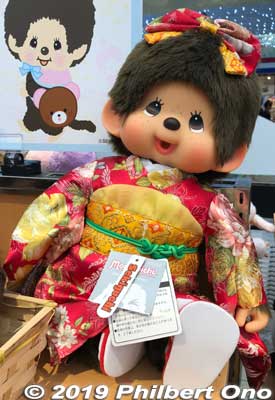
Moncchichi was invented by toy doll company Sekiguchi Corporation based in Shin-Koiwa in Katsushika Ward/City, Tokyo. The name “Moncchichi” would normally be spelled in English as “Monchicchi,” “Monchitchi,” or simply “Monchichi.” In France, it’s called “Kiki.” In the UK, it’s “Chicaboo,” and in Italy, “mon cicci.”
The cutesy and catchy name is stuffed with many meanings. The main meaning is “My cute little friend.” “Mon” means “my” in French as well as “monkey.” The “cchichi” sounds like a thumb- (or pacifier) sucking baby.
Moncchichi was soon dressed in an incredible variety of costumes and different fur colors for different occupations, characters, occasions, seasons, sports, nationalities, etc. Moncchichi plush toys also come in different sizes to suit any budget. Their cute, smiling, and uplifting faces have charmed many people in Japan and overseas. Definitely a part of Japan’s kawaii culture.
By 1986, the initial Moncchichi craze wore off and it disappeared from stores in Japan. However, from 1996, when kids in the 1970s and 1980s became adults, Japan saw a resurgence and nostalgia for 1970s kawaii characters including Hello Kitty and Moncchichi. The once popular characters found their way back into stores and have enjoyed a stable presence and sales ever since. As of 2022, 80 million Moncchichi plush toy dolls have been sold in Japan and overseas.
Meeting Moncchichi in Shin-Koiwa


Moncchichi got a further boost when Katsushika Ward/City (葛飾区) in eastern Tokyo started promoting itself as Moncchichi’s hometown. Since Moncchichi inventor Sekiguchi Co., Ltd. is based in Shin-Koiwa (新小岩) in Katsushika, the Katsushika local government proceeded to transform Shin-Koiwa into a Moncchichi town. This year in 2022, they added even more Moncchichi enhancements. Sekiguchi and Katsushika City have effectively cooperated and collaborated to make Shin-Koiwa worth visiting to meet Moncchichi. Just go to JR Shin-Koiwa Station on the JR Sobu Line. From Akihabara Station, it takes only about 14 minutes.
Katsushika has long played up its movie/manga/anime heritage for effective local PR, especially near local train stations (i.e. Tora-san in Shibamata and Tokyo Beat Cops at Kameari Station).
In the past 10 years, they have heavily spotlighted Moncchichi in its pop culture pantheon. It started in earnest on Dec. 2, 2012 when Katsushika Ward appointed Moncchichi as Katsushika’s “PR Manager,” a de facto official mascot.
In April 2016, a new public park nicknamed Moncchichi Park opened in Shin-Koiwa on the former site of the Sekiguchi factory. The park was later expanded in April 2022. (Details below.)
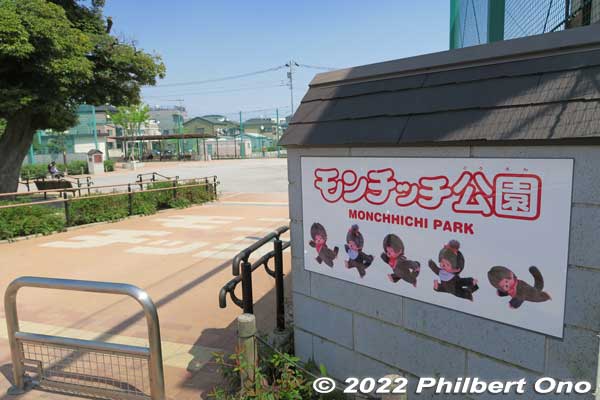
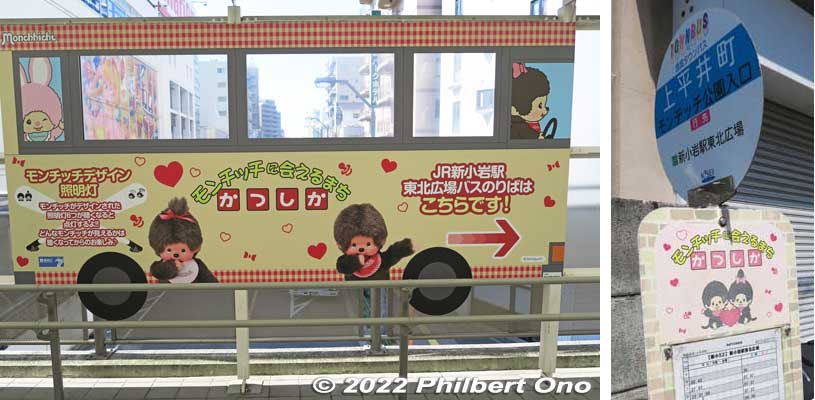
From February 2017, two local buses adorned with a Moncchichi bus wrap started running from Shin-Koiwa Station to JR Ichikawa (JR Sobu Line) and JR Kameari (JR Joban Line) Stations via Moncchichi Park. Bus stop signs to Moncchichi Park also have a Moncchichi design.

In June-July 2017, ten Moncchichi manhole covers (in color) were installed around JR Shin-Koiwa Station. Five of them are near the station’s south entrance, four are at the northeast Tohoku Open Space Area (Tohoku Hiroba) where there are bus stops, and one is near the station’s north entrance. They all have the same design.
Collectible Moncchichi manhole cards are also available for free (one card per person) at the Shibamata Tourist Information Office (柴又観光案内所) near Shibamata Station (Keisei Kanamachi Line). Shin-Koiwa Station has buses going to Shibamata.
From October 21, 2017, Moncchichi can be seen through augmented reality (AR) around JR Shin-Koiwa Station. You need to first download a smartphone app called Kokosil (ココシル) from GooglePlay or the iPhone AppStore and open it. Select the Katsushika-ku Sogo App and tap on “Shoot with AR.” You can take a selfie with Moncchichi in the spots where he appears as AR. Never tried it, so I don’t know how well it works. More info here.
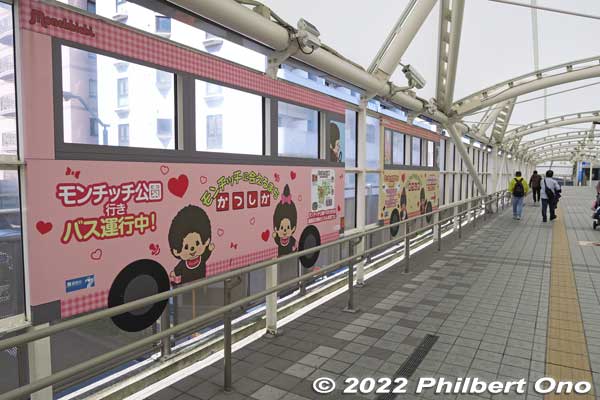
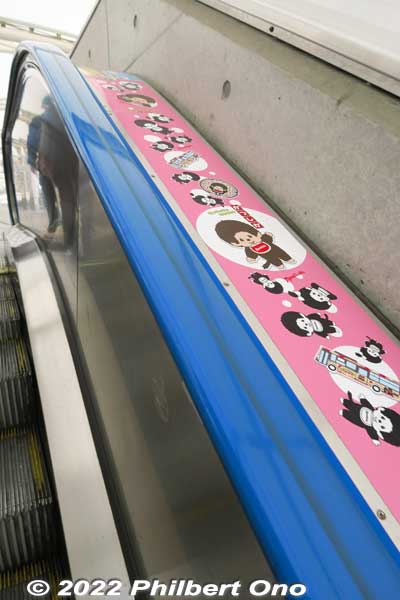
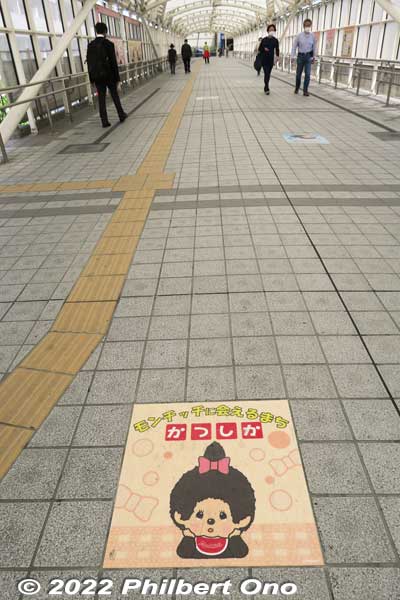
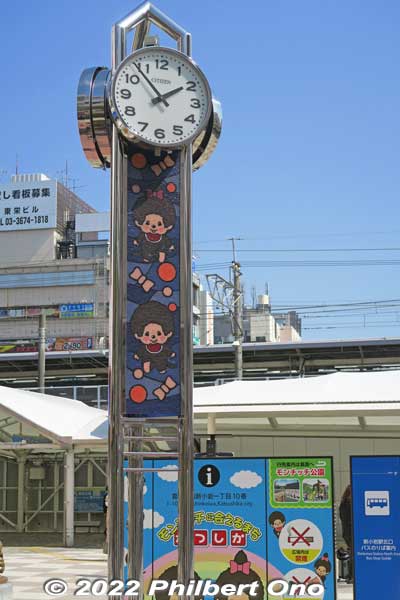
On March 10, 2018, a ceremony was held to mark the completion of Moncchichi decorations along the Skydeck Tatsumi (スカイデッキたつみ) elevated walkway from Shin-Koiwa’s north exit to the northeast Tohoku Open Space Area (Tohoku Hiroba 新小岩駅東北ひろば). They include Moncchichi on escalator handrails, walls, and floor tiles. Skydeck Tatsumi and the Tohoku Open Space Area (Tohoku Hiroba) first opened in March 2011.
On October 26, 2019, the annual Shin-Koiwa Station Tohoku Hiroba Festival (新小岩駅東北ひろばまつり) was held at the station’s Tohoku Open Space Area (Tohoku Hiroba) featuring musicians, singers, and other performers including Moncchichi boy and girl mascots (humans in costume) which you could photograph. (The festival was canceled in 2020 and 2021 due to the pandemic.)
In October 2020, the Monchicchi Clock Tower (モンチッチ時計塔) was installed in front of Shin-Koiwa Station’s north entrance (kitaguchi). The tower has stained glass on three sides showing Monchicchi. After sunset, it lights up. It would soon be joined by more Moncchichi.
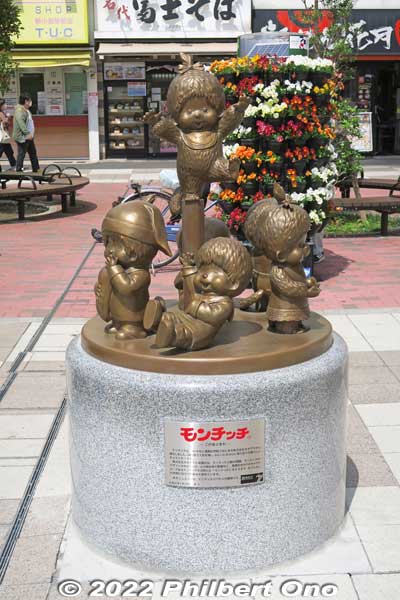
On January 26, 2022, Moncchichi’s 48th birthday, Shin-Koiwa Station saw the unveiling of Moncchichi statues in front of the north entrance. The Moncchichi statues were donated by Sekiguchi Koichi, former president and current chairman of Sekiguchi Corporation and nicknamed “Moncchichi Papa.” To a major newspaper, he remarked that he donated the monuments to give thanks to everyone who have supported Moncchichi. He was also pleased that the Moncchichi monuments were allowed to be placed in such a prime spot.
JR Shin-Koiwa Station is now a Moncchichi enclave. It makes the train station more interesting than ever before and worth visiting. Katsushika and Shin-Koiwa are indeed touting itself as the “Town where you can meet Moncchichi” (モンチッチに会える街). How cute. The people at Sekiguchi must be proud.
The Moncchichi monuments would be a great spot to meetup with friends at Shin-Koiwa Station. However, I didn’t see anyone waiting near the Moncchichi.
After getting your fill of Moncchichi at Shin-Koiwa Station, be sure to also visit Moncchichi Park, a short bus ride away. Read on for details.
*JR Shin-Koiwa Station in Katsushika Ward is not to be confused with neighboring JR Koiwa Station in Edogawa Ward. They are two different train stations in two different wards/cities.
Getting to Moncchichi Park
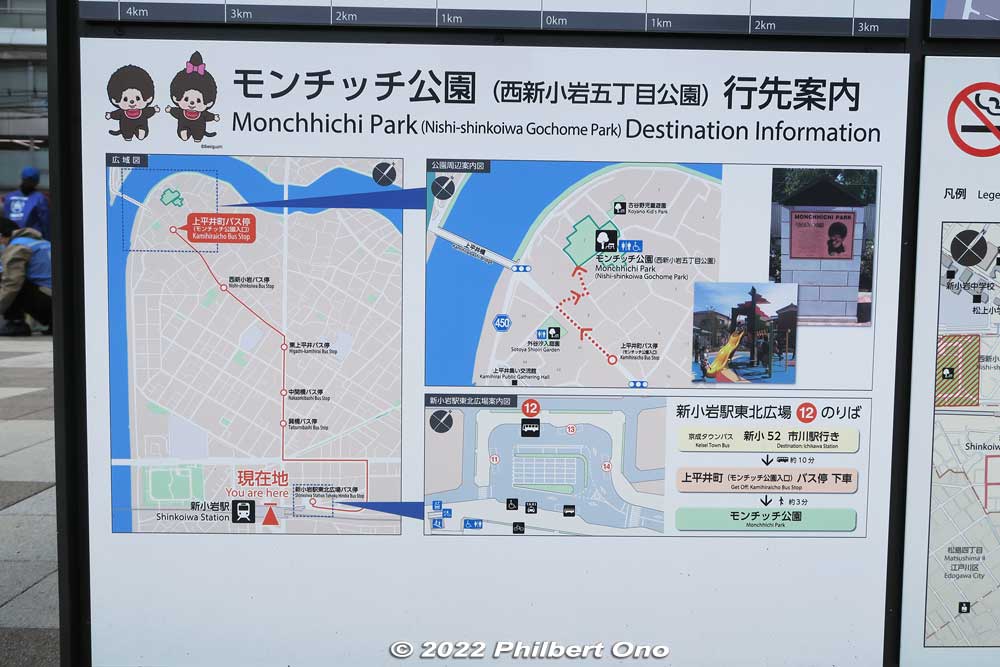
Moncchichi Park is a short bus ride from JR Shin-Koiwa Station. Note that Shin-Koiwa Station’s bus stops are scattered in multiple locations. First go out the station’s north exit (kitaguchi). Immediately go right and go up the escalator to the Skydeck Tatsumi elevated walkway. It goes straight to the northeast Tohoku Open Space Area bus stops (Tohoku Hiroba) (新小岩駅東北広場バスのりば). Go to bus stop 12 and take bus 52. It takes only 10 or 15 minutes until you get off at the Kami-Hiraicho (上平井町) bus stop. From there, the park is a short walk. There are utility pole signs pointing the way. See the Google Map below.
Moncchichi Park expanded in April 2022
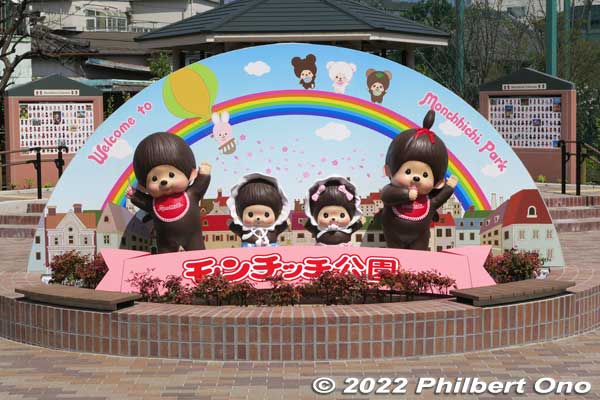
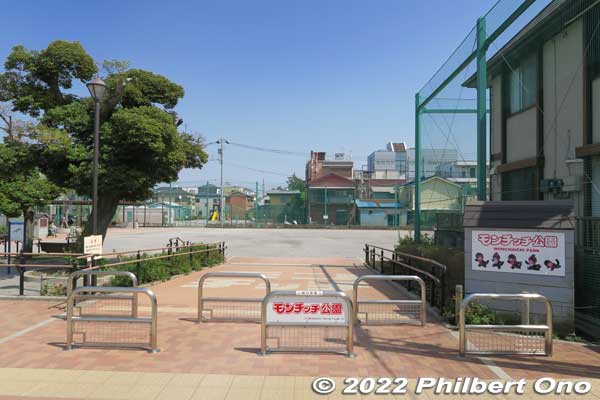

Opened on April 9, 2016 with a ceremony attended by many local dignitaries, Moncchichi Park is in a quiet residential neighborhood in Nishi Shin-Koiwa near Naka River. It’s a medium-size park (4,580 sq. meters) with a graveled ground, cobblestones, and playground equipment. It’s also an emergency evacuation zone for local residents. The park has a storehouse storing emergency provisions, manholes for makeshift toilets, wash basins, rainwater tank, and a few benches which can be converted into wood-burning stoves (かまどベンチ).
The park is where the original Sekiguchi factory and Sekiguchi family residence once stood. The factory moved overseas and the Sekiguchi residence was also relocated. The land was later acquired by Katsushika Ward to create the park. Sekiguchi Corporation’s head office remains nearby. Note that the head office is not open to the public. There’s no product showroom, etc.

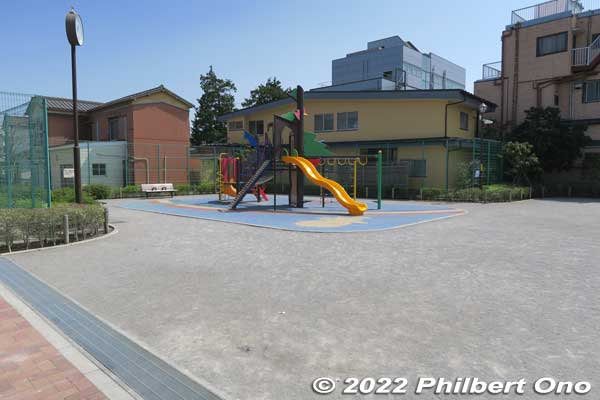
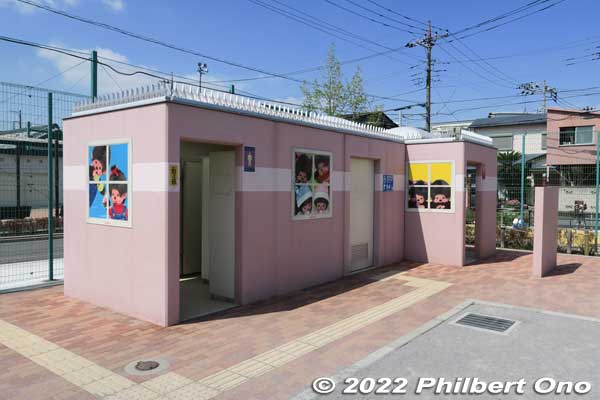
The local neighborhood association decided to nickname the park “Moncchichi Park” (Moncchichi Koen モンチッチ公園) while the official name is Nishi Shin-Koiwa 5-chome Koen (西新小岩五丁目公園) named after the park’s address.
Local residents thought that the original park that opened in April 2016 was still too bland and didn’t have enough of a Moncchichi theme. This was due to the fact that the park was also an emergency evacuation facility. So Katsushika Ward approved a plan to purchase adjacent lots to create park areas having a stronger Moncchichi flavor. It turned out to be a colorful and successful plan that cost ¥153 million. The Moncchichi statues were donated by the Sekiguchi company chairman.
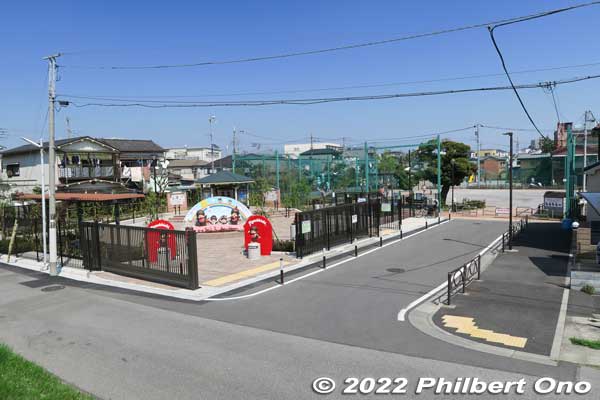

On April 2, 2022, Moncchichi Park was greatly enhanced by the opening of two new park areas next to the original park. The opening ceremony was attended by many local dignitaries. One new area is “Monchicchi Zone” (540 sq. meters) filled with Sekiguchi doll statues, benches, and the open-air Moncchichi Mini Museum. Very colorful and photogenic place for selfies with Monchicchi. One tall Monchicchi monument will spew water to cool off kids in summer. Note that while the park’s main area (evacuation zone) is open 24/7, Monchicchi Zone is gated and open from 9:00 a.m. to 6:00 p.m. during April to September and 9:00 a.m. to 5:00 p.m. during the other colder months. Also closed from Dec. 29 to Jan. 3.
The Mini Museum’s display panels explain about the history of Sekiguchi and Moncchichi. However, there’s no English. There’s also a video monitor, but it wasn’t working when I visited in mid-April.

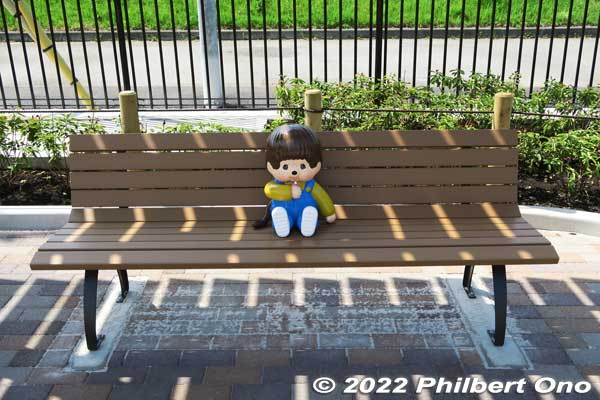
Another new section is Chibikko Hiroba (ちびっこ広場) with playground equipment for infants age 1 to 3. This colorful addition is 110 sq. meters.

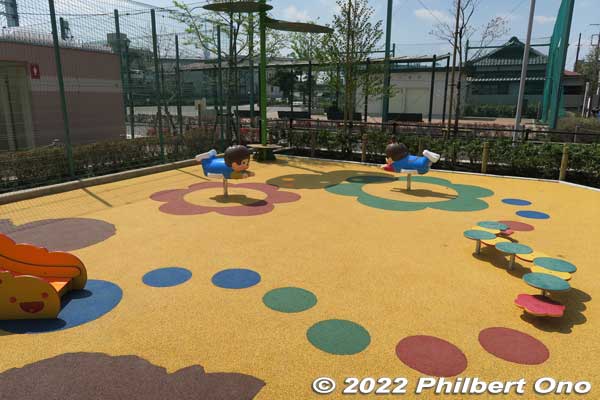
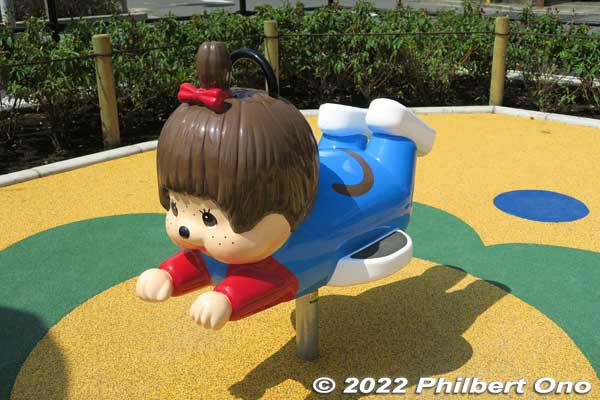
History of Sekiguchi and Moncchichi
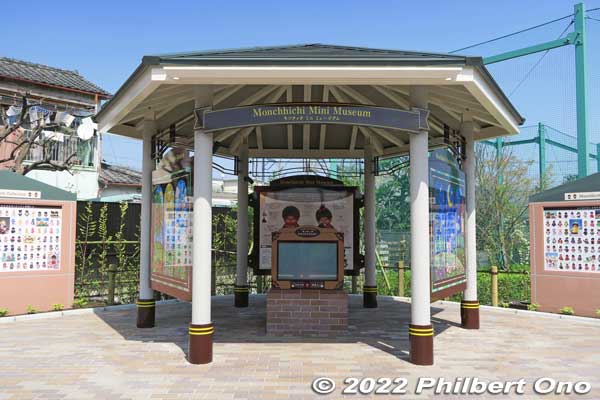
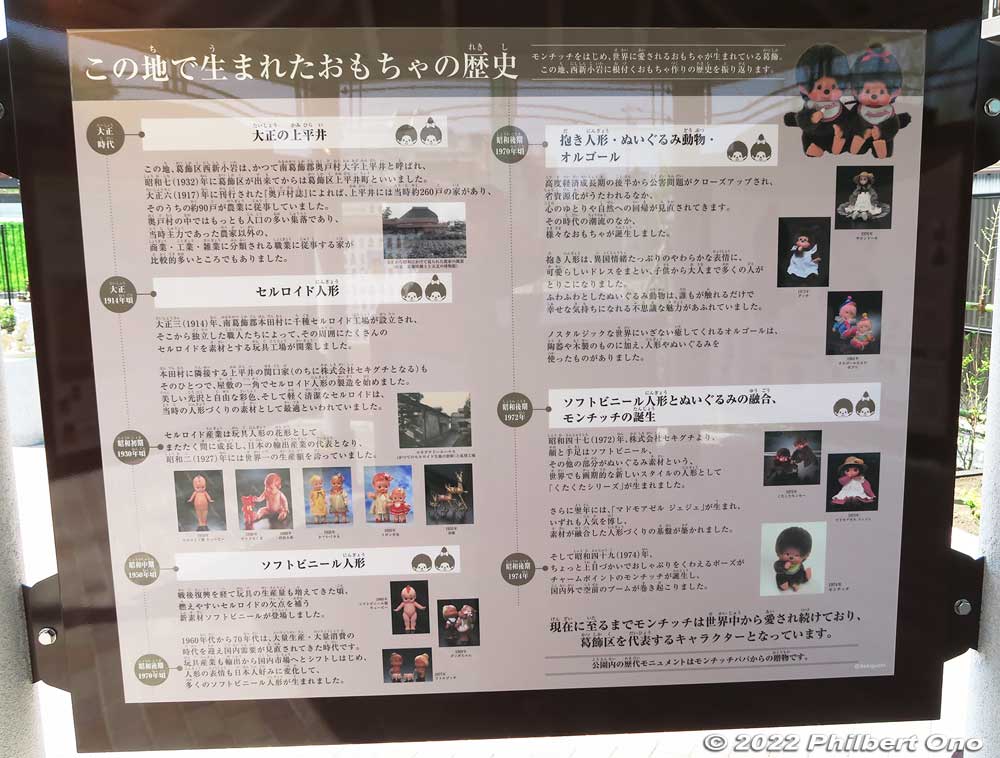
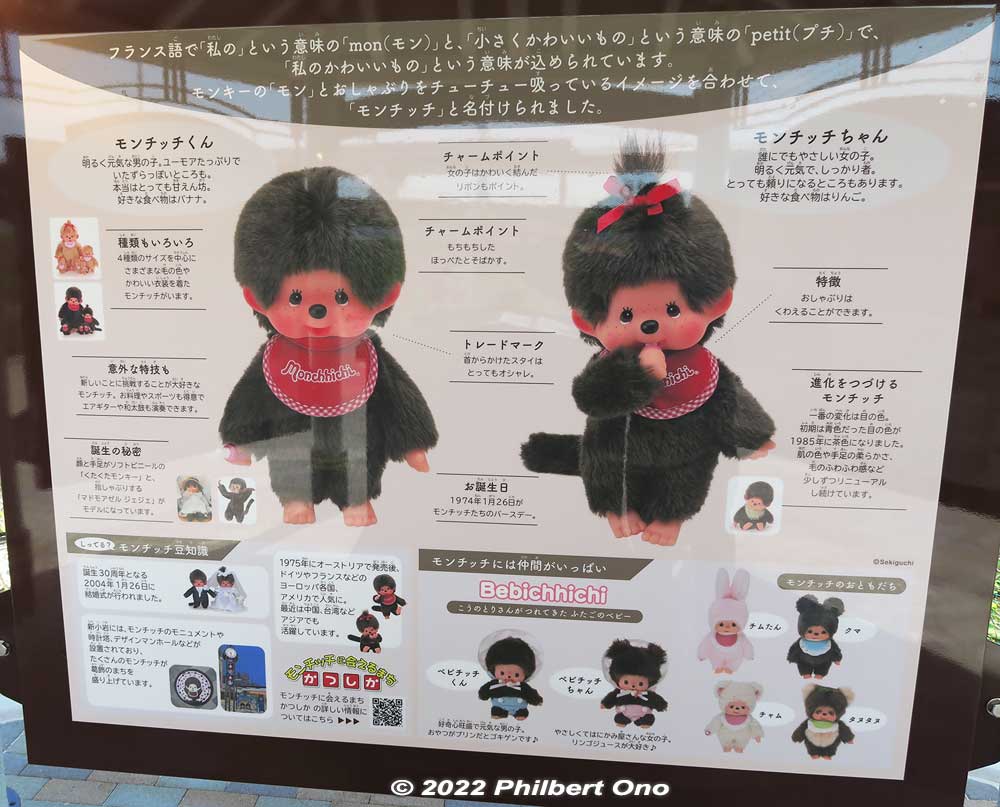
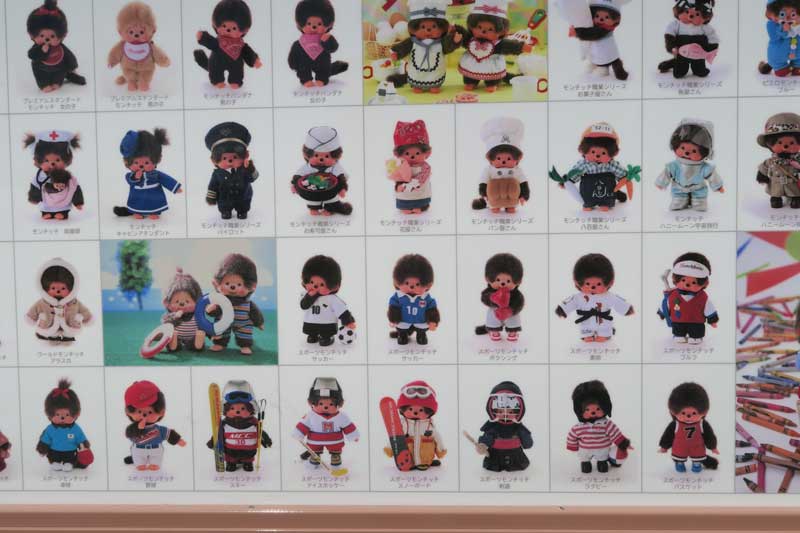
By the late 19th century, celluloid was the earliest form of plastic invented in the West. It became a widely-used material for toy doll making. It was lightweight, clean, lustrous, and easily colored. However, it was also highly flammable and even explosive in high heat and was consequently banned in toys by the mid-1950s.
In 1914, the Chigusa Celluloid Factory (千種セルロイド工場) opened in southern Katsushika in a village called Honden-mura (本田村) not far from Moncchichi Park. Many craftsmen at this factory eventually went independent and setup their own celluloid toy factories or worked as subcontractors. This area of Katsushika soon had many celluloid toy makers targeting the overseas market.
The Sekiguchi family was one of them when they set up shop here in Kami-Hirai in 1918. They made celluloid toy dolls under the name “Sekiguchi Celluloid Processing Factory” (関口セルロイド加工所). It was started by the grandfather of current company chairman Sekiguchi Koichi. The celluloid kewpie doll became very popular and famous. Japanese celluloid dolls were further improved by having rubber joints and moving limbs. Celluloid doll production prospered in this area of Katsushika until the latter 1940s.
By 1927, Japan exceeded Germany to become the world’s leading producer of celluloid toy dolls which became a major export item for Japan.
In 1954, America banned celluloid in dolls and toys due to its high flammability. This led to the suspension of celluloid toy production in Japan in 1955. This was also when Sekiguchi produced its last celluloid toys (toy deer).
From 1955, celluloid was replaced by soft plastics for toy doll making. The post-war years saw an increased demand for toys.
During Japan’s high economic growth and consumption of the 1960s–70s, Japanese toy makers shifted their focus to the domestic market. Meanwhile, Katsushika saw the post-war startup of many major toy makers and their subcontractors including Takara Co., Ltd.
By the early 1970s, soft, huggable dolls, especially stuffed animals, became popular. In 1972, Sekiguchi Co. came up with a unique and groundbreaking doll which was a stuffed, furry animal, but with the head and limbs made of soft plastics. It was the Kuta-Kuta exhausted monkey series.
In 1973, Sekiguchi had another hit product named Mademoiselle Jeje (マドモアゼル ジェジェ), a French-style girl doll sucking her thumb.
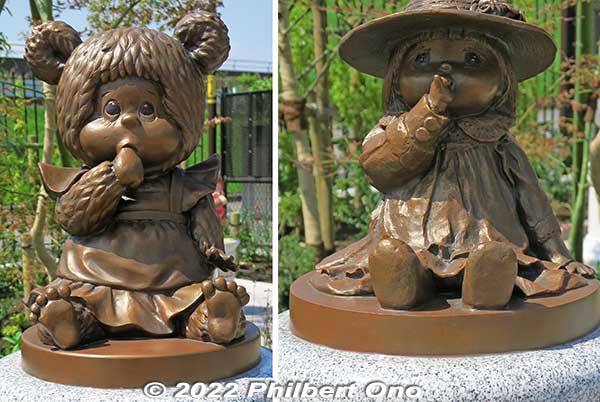
On the right is Mademoiselle Jeje. Displayed in the park’s Moncchichi Zone.
Finally on January 26, 1974, after tweaking the Kuta-Kuta monkey and incorporating Mademoiselle Jeje’s thumb-sucking, Moncchichi was released and became a megahit. This is considered to be Moncchichi’s birthdate which is also the current company chairman’s birthday.
Both the Kuta-kuta monkeys and Moncchichi were designed for Sekiguchi Co. by the late Washino Yoshiharu (ワシの良春) who was a Tokyo-based character designer.
The latter 1970s and early 1980s were Moncchichi’s heyday in popularity. It was also a hit in Europe, especially in Germany and France. In the US, Moncchichi was licensed by Mattel from 1980 to 1985 when sales lagged. Sekiguchi consequently pulled out of the US market, but later established its own US distributorship in 2002 to start selling Moncchichi to Americans again.
Sekiguchi doll museums
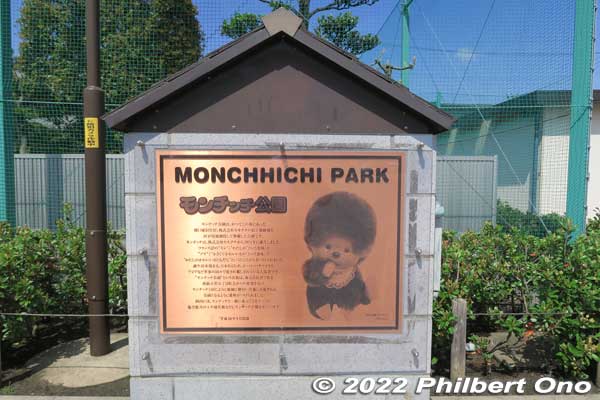
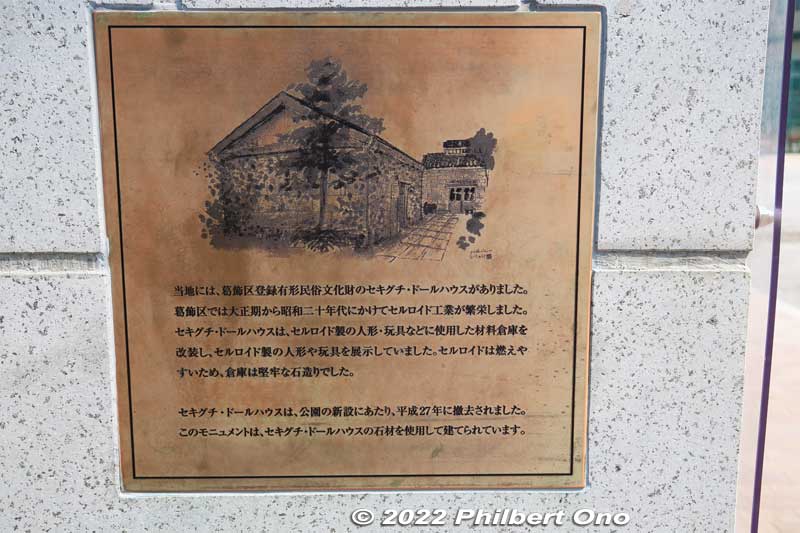
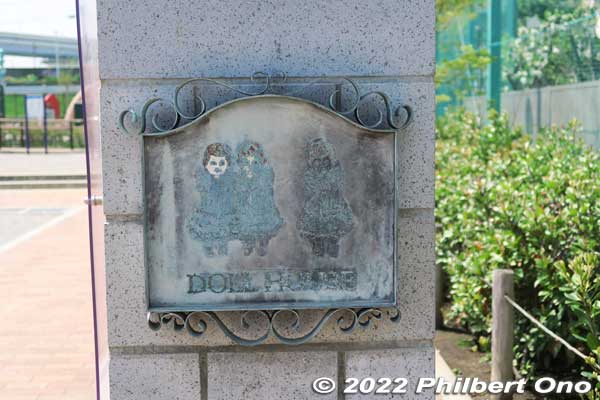
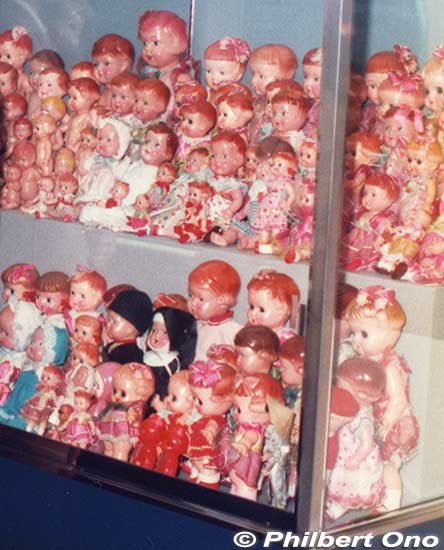
For many years, before Monchicchi Park became a park, the site had a small brick building that originally was the Sekiguchi factory’s storehouse for celluloid materials from 1918 to 1955 when Sekiguchi produced celluloid dolls and toys. The building was made of thick stone bricks because celluloid was highly flammable.
It was later converted into the Sekiguchi Doll House (セキグチ・ドールハウス) opened to the public (free admission, by appointment) from 1980. It was a small museum with glass showcases displaying the company’s earliest celluloid dolls (250 varieties) and toys (250 varieties) mostly for export. Those made soon after World War II were labeled “Made in Occupied Japan.” The year embossed on the dolls indicated the year when the respective mold was made, not necessarily when the doll was made.
Also in 1980, a limited edition, hardcover photo book titled The Doll was published by Sekiguchi Co. It has beautiful color photos of the company’s celluloid dolls. Only 1,000 copies were printed, and I have a copy.
The Sekiguchi Doll House and dolls it contained were designated as a Tangible Folk Cultural Property by Katsushika Ward in March 1990. However, the doll house was closed in 2010 and dismantled in 2015 to make way for the Moncchichi Park. The park now has a small monument marking the location of the Sekiguchi Doll House.
Sekiguchi Co. had another doll museum called Sekiguchi Doll Garden (セキグチドールガーデン) which opened in Nov. 1998 in Izu Kogen Highland on the Izu Peninsula in Ito, Shizuoka Prefecture. It was a substantial, modern building and included a cafe, gift shop, and park-like grounds. The museum’s management later changed and the museum became Izu Kogen Doll Garden (伊豆高原ドールガーデン) in April 2004. However, after only one year, this museum closed on June 6, 2005.
I don’t know where all those celluloid and antique dolls moved to, but it seems at least some of them are being exhibited at other doll museums such as the Yokohama Doll Museum and Kitahara Museum (nicknamed “Happy Days”) at Lake Kawaguchi in Yamanashi Prefecture.
More Moncchichi
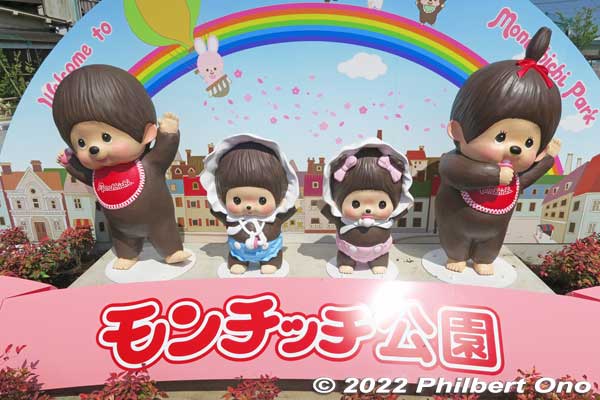
On January 26, 2004, the boy and girl Moncchichi got married. Sekiguchi employees came up with the idea to commemorate Moncchichi’s 30th anniversary. Although the original Moncchichi pair were fraternal twins, they were conveniently and magically reinvented to make them unrelated and therefore marriageable to each other. On October 30, 2004, fraternal twin babies (boy and girl) were born to the married Moncchichi couple. According to the official story, an Oriental white stork (kounotori) brought them into the world.
The twin babies were named “Bebichhichi” (ベビチッチ Baby cchichi). The boy baby is “Bebichhichi-kun” and girl baby “Bebichhichi-chan.” This family expansion reflected the life cycle of the original Moncchichi fans of the 1970s-80s who were now adults and becoming parents themselves. Moncchichi’s age is now ambiguous or perhaps ageless. Bebichhichi was also designed by the late Washino Yoshiharu.
Sekiguchi also created a few friends for Moncchichi such as a rabbit (Chimutan) and tanuki raccoon dog (Tanu-tanu). It also makes plush toys and merchandise for Snoopy (Peanuts), miffy, Moomin, Doraemon, Tom & Jerry, Studio Ghibli, Star Wars, and many others.

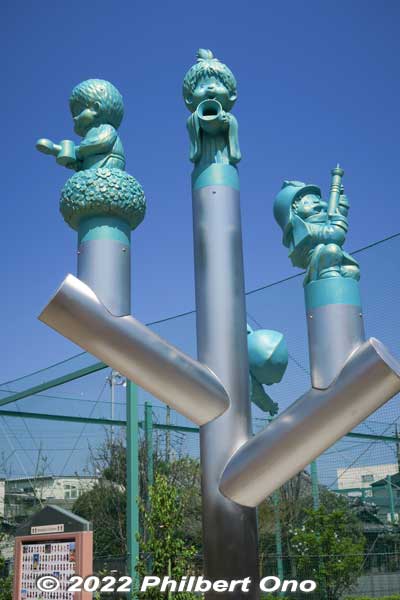
Moncchichi remains popular outside Japan especially in Asia and Europe. In Hong Kong, a resort hotel offered a Moncchichi staycation hotel room in summer 2021. And for two months in summer 2018, Kigsley Café hosted a Moncchichi Café.
At the Japan Expo 2018 in Paris, France, the Moncchichi booth attracted many people.
In Tokyo, the major toy stores selling Moncchichi include Kiddy Land in Harajuku/Omotesando, Toys Terao in Asakusa, Hakuhinkan Toy Park in Ginza, and Haikara Yokocho in Decks Odaiba and Yokohama World Porters. Other vendors in Japan listed here.
Sekiguchi also has an official online shop for Japan and Asia (Southeast Asia, Taiwan, Singapore) and official website for Europe in European languages.
After many years as an ordinary bedroom/commuter town in Tokyo, Shin-Koiwa has come a long way in making a name for itself. It’s now a Moncchichi Town and perhaps tourist attraction. Very happy to see Moncchichi and Sekiguchi finally getting more local credit and recognition.
*More Moncchichi photos in Shin-Koiwa: https://photoguide.jp/pix/thumbnails.php?album=1152
後記:だいぶん前の話しですが、当時の株式会社セキグチの社長であった関口晃市様と知り合いました。英語もできて人柄がとてもいい方でした。私どもを本社やDoll Houseへ案内していだたきました。それ以来、モンチッチは忘れない懐かしい思い出になりました。現会長は80代にも元気そうでこんな立派な公園や駅前のモニュメントなど、素晴らしい「夢」が実現できて本当に嬉しいですね。私もこれらを見て感激しました。故郷のプライドと愛着はとても重要だと思います。今後もモンチッチという遺産が後世の国内外の子どもたち(大人も)にlove and happinessを与えつづけるように祈っております。
Official Moncchichi website: https://www.monchhichi.co.jp/
Official Sekiguchi website: https://www.sekiguchi.co.jp/
Katsushika Ward’s Moncchichi page: https://www.city.katsushika.lg.jp/tourism/1000064/1027603.html
